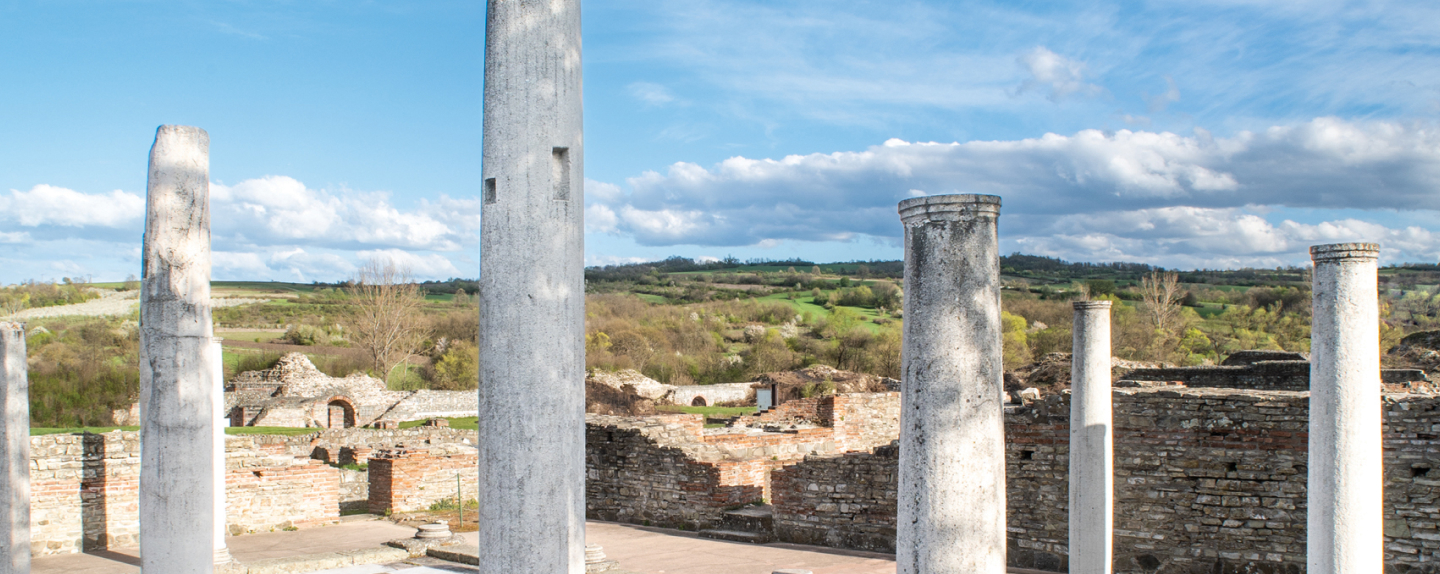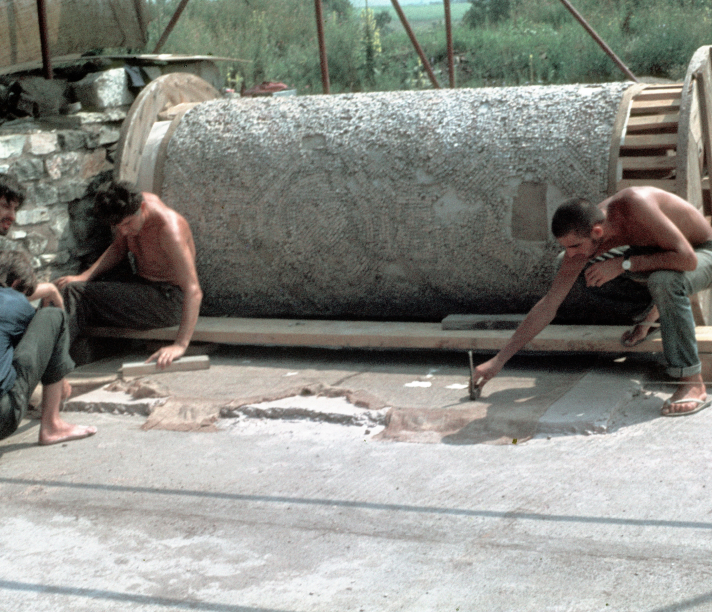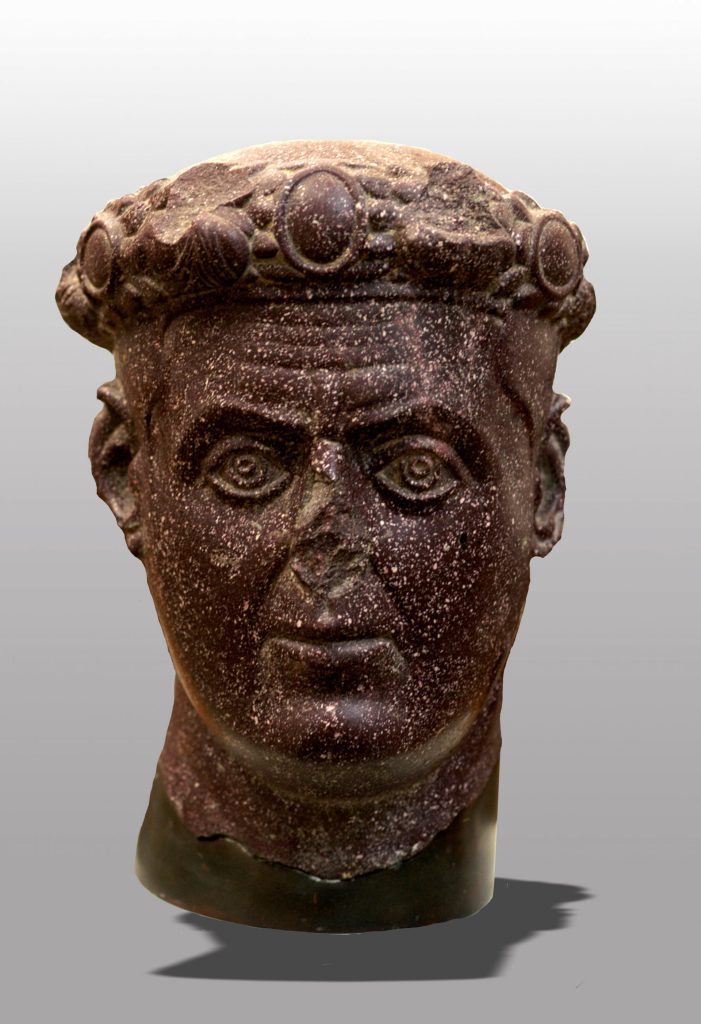
About Felix Romuliana

About Felix Romuliana
The earliest descriptions and professional evaluations of Gamzigrad were provided by the Saxon mining chief Baron Von Herder in 1835. During the second half of the 19th century, Austrian archaeologist, historian, and travel writer Felix Kanitz became particularly interested in the site. He visited the ruins of Gamzigrad twice, in 1860 and 1864, and created significant drawings of the visible parts of the walls and towers, as well as the entire surrounding area, which he described in his works on Serbia. He repeatedly emphasized that Gamzigrad is “one of the most splendid monuments of past times” and “one of the largest and best-preserved monuments of Roman architecture in Europe.”
Thanks to the efforts of Vekoslav Popović, then the director of the National Museum in Zaječar, systematic archaeological research at Gamzigrad began in 1953.

Galerius (Gaius Valerius Maximianus Galerius) is one of the sixteen Roman emperors born in what is now Serbia. He was born around 260 AD as Maxim in a location near present-day Gamzigrad, approximately 11 kilometers from Zaječar, in today’s eastern Serbia, which was part of the Roman province of Lower Dacia (Dacia Ripensis). In the place of his birth, a significant urban settlement established in prehistoric times, Galerius, as Emperor Gaius Galerius Valerius Maximianus (293–311), constructed a magnificent palace dedicated to his mother, Romula. This is where the name Felix Romuliana originates, commemorating the divine nature of both his mother and himself. The term Romuliana can be interpreted as Romula’s villa or house.
The emperor’s mother, whose real name we do not know, was a refugee from Dacia, and his father, whose name is also unknown, was a well-served soldier (veteran), who received the use of a small estate in the place of Galerius’ birth. As a child, Galerius most likely looked after cattle, which is why he was nicknamed Armentarius (cattleman) throughout his life, which his opponents were particularly pleased to point out. Later, he followed his father’s path and served as a soldier under the emperors Aurelian and Probus. As a particularly brave soldier, he distinguished himself under Emperor Diocletian, the founder of the new system of ruling the Roman Empire, the tetrarchy. That is why Diocletian adopted him, married his daughter Valeria and declared him his ruler in the East (293). Galerius managed to defeat the previously invincible Persia in 298, which marked a turning point in his further career and paved his further life path.

During his lifetime, Galerius was to reside in the palace as a senior Augustus, while after his death, he was to be honored as a god (divus), most likely in a temple located in the southern part of Romuliana and in the sacred complex on Mount Magura dedicated to him. On Mount Magura, about 1 km from the main gate of Romuliana, there is a sacred complex that includes two mausoleums—one for Galerius and one for Romula—along with two consecrated monuments in the form of giant tumuli. These massive mounds with stone foundations mark the site where, for the last time in the Roman world, an apotheosis ceremony took place, elevating the emperor and his mother among the gods after their deaths.
History has branded him as one of the greatest persecutors of Christians, overshadowing the fact that he, just two years before the famous Edict of Milan by Emperor Constantine in 313, introduced the first legal act of religious tolerance on his deathbed. Interestingly, these two compatriots and irreconcilable opponents ruled together during the period of 306-311 AD due to historical circumstances.
After Galerius’s death, the space of his unused palace became a vibrant center of crafts and trade in late antiquity. Intensive craftsmanship, primarily iron metallurgy, continued even into the early Byzantine period. Additionally, in the 6th century, during the reign of Emperor Justinian I (527-565), Gamzigrad could have been the center of a church community, enriched with both new and existing churches. The rich life within the impregnable walls of the former palace of Galerius continued until the mid-11th century.
In 2007, Galerius’s palace in Gamzigrad was inscribed on the UNESCO World Heritage List based on two criteria. The first is that the “fortification, palace, and memorial complex are a unique testimony to Roman architectural tradition interwoven with the ideological program of the period of the second Tetrarchy and Galerius as its builder.” The second criterion is that the “group of buildings that constitutes the architectural complex of Emperor Galerius is unique in that it intertwines sacred and memorial programs.”
The Gamzigrad palace is distinctive, fortified by a double wall: an older one from the late 3rd century with 16 towers, and a newer, much more impressive fortification from the early 4th century with 20 gigantic polygonal towers. The main entrance to the palace is located on the east, but visitors today enter through the western gate of the palace.
The most significant architectural decorative elements and sculptures that adorned the palace are preserved in the National Museum in Zaječar. These include the archivolt with the inscribed FELIX ROMULIANA, a pilaster depicting the tetrarchs in medallions, the porphyry head of Emperor Galerius, the head of Jupiter, part of the colossal statue of the supreme deity, the head of Hercules, and three mosaics: Dionysus at the Feast, Labyrinth, and Venatori, the imperial hunters of wild beasts.
During his lifetime, Galerius was to reside in the palace as a senior Augustus, while after his death, he was to be honored as a god (divus), most likely in a temple located in the southern part of Romuliana and in the sacred complex on Mount Magura dedicated to him. On Mount Magura, about 1 km from the main gate of Romuliana, there is a sacred complex that includes two mausoleums—one for Galerius and one for Romula—along with two consecrated monuments in the form of giant tumuli. These massive mounds with stone foundations mark the site where, for the last time in the Roman world, an apotheosis ceremony took place, elevating the emperor and his mother among the gods after their deaths.
History has branded him as one of the greatest persecutors of Christians, overshadowing the fact that he, just two years before the famous Edict of Milan by Emperor Constantine in 313, introduced the first legal act of religious tolerance on his deathbed. Interestingly, these two compatriots and irreconcilable opponents ruled together during the period of 306-311 AD due to historical circumstances.
After Galerius’s death, the space of his unused palace became a vibrant center of crafts and trade in late antiquity. Intensive craftsmanship, primarily iron metallurgy, continued even into the early Byzantine period. Additionally, in the 6th century, during the reign of Emperor Justinian I (527-565), Gamzigrad could have been the center of a church community, enriched with both new and existing churches. The rich life within the impregnable walls of the former palace of Galerius continued until the mid-11th century.
In 2007, Galerius’s palace in Gamzigrad was inscribed on the UNESCO World Heritage List based on two criteria. The first is that the “fortification, palace, and memorial complex are a unique testimony to Roman architectural tradition interwoven with the ideological program of the period of the second Tetrarchy and Galerius as its builder.” The second criterion is that the “group of buildings that constitutes the architectural complex of Emperor Galerius is unique in that it intertwines sacred and memorial programs.”
The Gamzigrad palace is distinctive, fortified by a double wall: an older one from the late 3rd century with 16 towers, and a newer, much more impressive fortification from the early 4th century with 20 gigantic polygonal towers. The main entrance to the palace is located on the east, but visitors today enter through the western gate of the palace.
The most significant architectural decorative elements and sculptures that adorned the palace are preserved in the National Museum in Zaječar. These include the archivolt with the inscribed FELIX ROMULIANA, a pilaster depicting the tetrarchs in medallions, the porphyry head of Emperor Galerius, the head of Jupiter, part of the colossal statue of the supreme deity, the head of Hercules, and three mosaics: Dionysus at the Feast, Labyrinth, and Venatori, the imperial hunters of wild beasts.
Guide service
Free parking
Souvenir shop
Audio guide
Our history